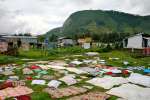Rwandan cooperative shows reconciliation needed to draw refugees home
News Stories, 8 February 2006

MARABA, Rwanda, 8 Feb (UNHCR) – Peace has returned to Rwanda but life for Beatrice, a coffee grower who lost her husband and a son during the 1994 genocide, is not easy with six children at home to feed.
The years following the war were especially difficult in her region of Maraba, a district located in the Southern province of Butare that had the highest percentage of victims during the genocide. Many harvests were abandoned and poverty and misery gripped the province, inflicting terrible consequences on the remaining people's livelihoods. Coffee production dropped 55 per cent, accompanied by a fall in its quality.
In 1999 Beatrice found new hope in Abahuzamugambi, a farming association that was then taking its first steps with about 200 members. The name translates as "those who have a common goal" and is the sort of activity that could help draw back the nearly 57,000 Rwandans who remain outside their country, still not persuaded to return despite the offer of repatriation by the UN refugee agency.
UNHCR, which considers voluntary repatriation an essential part of achieving peace and stability in the region, has upgraded its monitoring of returnees in Rwanda, which helps in reintegration and the provision of information on conditions to remaining refugees.
"In Rwanda coffee growers working on their own cannot make a living. You work very hard for a ridiculous price paid in the local market," Beatrice said. "This is the reason why I decided to join Abahuzamugambi, whose members fight for better prices in the market to obtain a fairer compensation to our work."
The association became a cooperative and today has 1,768 members, of which 936 are women. Some, like Beatrice, lost relatives during the genocide while others have husbands in prison waiting to be judged by gacaca popular tribunals for involvement in crimes during the genocide.
François, the executive secretary of Abahuzamugambi, said with pride that "in the cooperative everybody works together with the aim to reach a better living standard for coffee farmers in Maraba." He said "women come together to work, they eat together and socialize."
Some 70 percent of the money received for the coffee is shared among the members, while 30 percent is invested in the cooperative. The coffee is exported to two companies in the U.S. and Britain after a long process to achieve the best quality of the area's Arabica Bourbon coffee. Production rose from 30 tonnes in 2002 to 65 tonnes in 2005.
"The lives of the neighbours in Maraba have improved a lot with the progress made by the cooperative, and now we have in the village some shops, two hairdressers and a kindergarten funded by Abahuzamugambi," said François,
The president of the cooperative is Joyeuse, an ironic name for a woman whose eyes reflect a deep sadness and resignation after the loss of her husband during the genocide.
But she said: "the association has given to those women affected in one way or another by the war new reasons to live. I have three teenagers at home whose studies I can afford now, even if the money is still very little."
Domina also has found the money to educate her two children, though her situation is different – her husband has been in the Central Prison of Butare for eight years.
"It is only possible thanks to the cooperative, which has greatly reduced the amount of work of members as we do not need to worry about selling in the market. This allowed us to cultivate other products like sweet potatoes or manioc to obtain additional income," she said.
Members of Abahuzamugambi agree the big advantage of the cooperative is that it seeks the price of the international market, which is generally higher than the local market. In October 2002 Abahuzamugambi was fairtrade-certified, which meant inclusion of a premium reserved for sustainable business and social development programmes.
This certification is also due to Abahuzamugambi following an environmentally friendly policy that excludes use of chemical fertilizers. The cooperative won the International Environment Prize for Sustainable Development in Goteborg, Sweden.
Beatrice, Domina or Joyeuse all suffered the tragic consequences of the war in different ways. Now they are working together for a better life, proof that reconciliation is possible.
By Beatriz Gonzalez in Maraba, Rwanda
































































